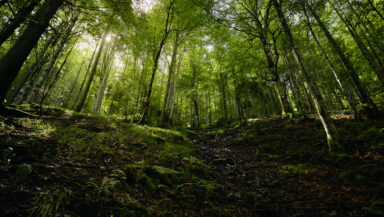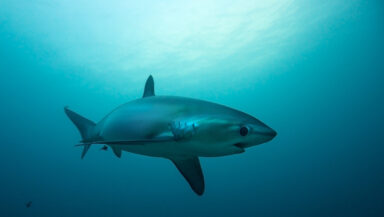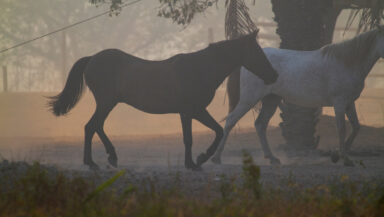What Animals Have Become Extinct In The Last 100 Years
Listen to this article read aloud by the Greenpeace squad.
Extinction is a discussion scientists use to describe a species dying out. This can happen naturally, simply humans are often to blame. One 1000000 animal and plant species are threatened with extinction worldwide.
This video shows some of the animals that went extinct over the final 100 years, with a timeline showing the decade of their untimely demise. You tin read more than below about the reasons backside these losses in the globe's rich biodiversity.
Overwhelmingly, humans play a major office in driving the extinctions of all kinds of species: from hunting, colonialism, agronomics causing habitat loss to – more recently – industrial agriculture, air pollution and climate change.
Paradise parrot
Formerly found in eastern Australia, the Paradise parrot has not been seen since 1928. According to the International Matrimony for the Conservation of Nature (IUCN)'due south 'Red List' of threatened species, information technology went extinct mainly to drought, overgrazing of subcontract animals, and people cutting downwards eucalyptus copse.
Sicilian wolf
Co-ordinate to a report from the Natural History Museum of Verona , the Sicilian wolf was driven to extinction by humans due to its appetite for farmers' livestock. Native to Sicily, it's as well idea that these wolves ran out of wild food to eat during an environmental crisis on the island.
Tasmanian tiger
European colonists were afraid of the Tasmanian tiger and thought they might prey on their sheep, so they hunted and killed them to reduce their numbers. But in later years equally the Tasmanian tiger became rarer, the main reason for hunting past humans was for show in museums and zoos. The last one died in Hobart Zoo in 1936.
Xerces blue butterflies
The Xerces bluish collywobbles lived in the coastal sand dunes of the San Francisco Peninsula. Scientists believe that they were driven to extinction in the early on 1940s ; the first American butterfly species to get extinct as expanding cities took over their habitats.
Japanese sea king of beasts
Japanese sea lions were hunted for their skins, whiskers, organs and oil, and were besides captured for the circus trade. This, in combination with persecution by fishermen and perhaps shooting by soldiers, likely caused their extinction. They were last seen in the 1950s.
Crescent nail-tail wallaby
These small marsupials were mutual in southwestern and fundamental Australia until foxes and cats that were introduced by European colonists started preying on them. Damage to their habitat may have contributed to their extinction in the 1950s.
Bubal hartebeest
Co-ordinate to the IUCN , humans over-hunted the Bubal hartebeest over many years, perhaps even centuries, somewhen causing its extinction. Until the 1950s, they lived in the grasslands of North Africa, and are thought to exist featured in artwork found in tombs of ancient Egyptians.
St. Helena Darter
This dragonfly, found merely on the volcanic island of St. Helena in the Atlantic, is considered extinct as the last was seen in 1963. It's thought that the Darter'due south decline is down to severe habitat destruction after the island was colonised in the tardily sixteenth century. New 'invasive' species introduced past humans, such as the African clawed frog, also contributed to its extinction.
Kākāwahie
This Hawaiian bird was last seen in the Kamakou Preserve in 1963. According to the IUCN, it was common in the 1890s , the extinction of the Kākāwahie was due to habitat destruction, and disease spread by mosquitoes introduced by humans.
Guam flying play a trick on
According to the IUCN , the Guam flying trick'due south was driven to extinction by humans hunting it for food, and the introduction (again, by humans) of the predatory Brown tree snake. The concluding of these niggling fruit bats was shot by hunters, and it's not been spotted with whatever reliability since 1968.
Caspian tiger
The Caspian Tiger was one of the largest big cats on the planet – males could be nigh three metres long. Last seen in the 1970s, its decline began in the tardily nineteenth century every bit it was hunted by Russian colonial soldiers and its habitat was destroyed by people immigration land for farming.
Siamese apartment-barbelled catfish
The Siamese flat-barbelled catfish was a victim of humans edifice on land and rivers until its last sighting betwixt 1975 and 1977. Damming, culvert-edifice and high pollution in the Chao Phraya River, and the draining of wetlands in and effectually Thailand's capital Bangkok are idea to have caused its extinction.
Yunnan lake newt
The Yunnan lake newt went extinct because its Kunming Lake habitat in China was destroyed and damaged by pollution, humans creating new land from parts of the lake, duck farming and the introduction of exotic fish and frog species. It was last seen in 1979.

Golden toad
The freshwater Golden toad, from Republic of costa rica's cloud forests, went extinct for a number of reasons. Co-ordinate to the IUCN , global warming, an infectious affliction, and air pollution all played a part. Formerly a mutual species, it'southward not been seen since 1989.
Rotund rocksnail
The Rotund rocksnail was once found in the Coosa River in Alabama. It's not been seen since the river was transformed by seven dams and powerhouses used to generate electricity in the 1990s.
Pyrenean ibex
The Pyrenean ibex was a type of goat abundant across the Pyrenees mountains. It declined over two centuries from hunting, disease and inability to compete with other species. The last was a female person called Celia, who died in 2000. In a kickoff, it was declared 'unextinct' in 2003 when a cloned female ibex was built-in live, but died several minutes later from lung defects.
Pinta giant tortoise
According to the IUCN , the Pinta giant tortoise, a species of Galápagos tortoise native to Republic of ecuador'south Pinta Island, was hunted past nineteenth century mariners for on-board food supplies. Twentieth-century fishers connected hunting the shrinking population. So goats, introduced past humans to Pinta in 1959, destroyed the tortoises' habitat. With the death of the last known Pinta Tortoise, Lonesome George (in captivity since 1972), in June 2012, the species went extinct.
Westward African black rhinoceros
The Due west African blackness rhinoceros was alleged extinct in 2011. According to Scientific American : 'At the get-go of the 20th century, an estimated i meg black rhinoceroses from four different subspecies roamed the savannas of Africa. By 2001 that number had dropped to about 2,300 black rhinos and just three subspecies. Widespread sports hunting in the get-go decades of the century quickly decimated rhino populations. Industrial agriculture came next, clearing many historic rhinoceros habitats for fields and settlements.'
Support Greenpeace
Experts are warning that in 50 years, one in three species of plants and animals may exist lost. Human activity is to blame – from destruction of habitats to climate change. We are raising funds to calibration up our work to protect our natural world from these major drivers of animal extinction.
Donate

This winter, the common cold, dark nights have been brightened upwardly past The Green Planet, David Attenborough'south latest natural history epic. Here are the top moments when our preconceptions virtually plants were blown make clean away.

I'll never forget my beginning time diving with sharks. Fourth dimension seems to stand up withal when you're in the presence of these magnificent animals. Many people are scared of sharks, but should they be more agape of us?

The world'southward largest wetland, the Brazilian Pantanal, was ravaged past fires in 2020. A new Greenpeace report reveals that United kingdom of great britain and northern ireland supermarkets, including Tesco, and fast food companies are funding the destruction.
Source: https://www.greenpeace.org.uk/news/18-animals-that-went-extinct-in-the-last-century/
Posted by: privetthaveracter.blogspot.com


















0 Response to "What Animals Have Become Extinct In The Last 100 Years"
Post a Comment